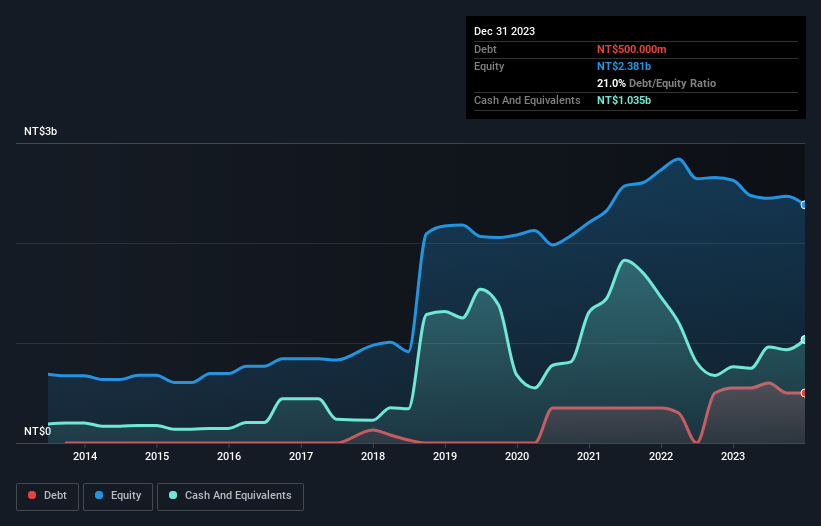- Taiwan
- /
- Electronic Equipment and Components
- /
- TWSE:3530
Silicon Optronics (TWSE:3530) Has Debt But No Earnings; Should You Worry?
The external fund manager backed by Berkshire Hathaway's Charlie Munger, Li Lu, makes no bones about it when he says 'The biggest investment risk is not the volatility of prices, but whether you will suffer a permanent loss of capital.' It's only natural to consider a company's balance sheet when you examine how risky it is, since debt is often involved when a business collapses. We note that Silicon Optronics, Inc. (TWSE:3530) does have debt on its balance sheet. But the more important question is: how much risk is that debt creating?
What Risk Does Debt Bring?
Debt assists a business until the business has trouble paying it off, either with new capital or with free cash flow. Part and parcel of capitalism is the process of 'creative destruction' where failed businesses are mercilessly liquidated by their bankers. However, a more common (but still painful) scenario is that it has to raise new equity capital at a low price, thus permanently diluting shareholders. By replacing dilution, though, debt can be an extremely good tool for businesses that need capital to invest in growth at high rates of return. When we examine debt levels, we first consider both cash and debt levels, together.
See our latest analysis for Silicon Optronics
What Is Silicon Optronics's Net Debt?
The image below, which you can click on for greater detail, shows that Silicon Optronics had debt of NT$500.0m at the end of December 2023, a reduction from NT$550.0m over a year. But on the other hand it also has NT$1.03b in cash, leading to a NT$535.0m net cash position.

How Healthy Is Silicon Optronics' Balance Sheet?
According to the last reported balance sheet, Silicon Optronics had liabilities of NT$546.2m due within 12 months, and liabilities of NT$201.0m due beyond 12 months. On the other hand, it had cash of NT$1.03b and NT$81.6m worth of receivables due within a year. So it actually has NT$369.4m more liquid assets than total liabilities.
This short term liquidity is a sign that Silicon Optronics could probably pay off its debt with ease, as its balance sheet is far from stretched. Succinctly put, Silicon Optronics boasts net cash, so it's fair to say it does not have a heavy debt load! When analysing debt levels, the balance sheet is the obvious place to start. But you can't view debt in total isolation; since Silicon Optronics will need earnings to service that debt. So when considering debt, it's definitely worth looking at the earnings trend. Click here for an interactive snapshot.
Over 12 months, Silicon Optronics made a loss at the EBIT level, and saw its revenue drop to NT$1.7b, which is a fall of 18%. We would much prefer see growth.
So How Risky Is Silicon Optronics?
While Silicon Optronics lost money on an earnings before interest and tax (EBIT) level, it actually generated positive free cash flow NT$325m. So although it is loss-making, it doesn't seem to have too much near-term balance sheet risk, keeping in mind the net cash. With mediocre revenue growth in the last year, we're don't find the investment opportunity particularly compelling. When analysing debt levels, the balance sheet is the obvious place to start. However, not all investment risk resides within the balance sheet - far from it. These risks can be hard to spot. Every company has them, and we've spotted 2 warning signs for Silicon Optronics (of which 1 doesn't sit too well with us!) you should know about.
When all is said and done, sometimes its easier to focus on companies that don't even need debt. Readers can access a list of growth stocks with zero net debt 100% free, right now.
New: Manage All Your Stock Portfolios in One Place
We've created the ultimate portfolio companion for stock investors, and it's free.
• Connect an unlimited number of Portfolios and see your total in one currency
• Be alerted to new Warning Signs or Risks via email or mobile
• Track the Fair Value of your stocks
Have feedback on this article? Concerned about the content? Get in touch with us directly. Alternatively, email editorial-team (at) simplywallst.com.
This article by Simply Wall St is general in nature. We provide commentary based on historical data and analyst forecasts only using an unbiased methodology and our articles are not intended to be financial advice. It does not constitute a recommendation to buy or sell any stock, and does not take account of your objectives, or your financial situation. We aim to bring you long-term focused analysis driven by fundamental data. Note that our analysis may not factor in the latest price-sensitive company announcements or qualitative material. Simply Wall St has no position in any stocks mentioned.
About TWSE:3530
Silicon Optronics
Designs, develops, and sells CMOS image sensors in Taiwan, Hong Kong, China, and internationally.
Flawless balance sheet with minimal risk.
Similar Companies
Market Insights
Community Narratives




